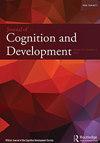The Association between Approximate Number Sense (ANS) and Math Achievement Depends on the Format of the ANS Test
IF 2.1
2区 心理学
Q3 PSYCHOLOGY, DEVELOPMENTAL
引用次数: 1
Abstract
ABSTRACT There are two lines of discussion regarding the function of the Approximate Number System (ANS). The first line focuses on the extent to which visual cues affect the estimation of numerosity. The second line investigates the extent to which ANS precision is associated with symbolic math performance. The current study combined these two lines of discussion. Data from the nonsymbolic comparison test and the math achievement of 313 first graders (mean age: 7.6 years; 51% girls) from Russia were analyzed. First, we estimated the extent to which the effect of nonnumerical visual cues on nonsymbolic numerosity estimation varied across the four formats of stimulus presentation: separated/homogenous, separated/heterogeneous, mixed/homogeneous and mixed/heterogeneous. The results revealed that in the mixed/heterogeneous format of stimulus presentation, the congruency effect was not significant with respect to accuracy and was negative with respect to reaction time (RT). The reduction in the congruency effect may indicate that in this format, the participants tended to directly estimate numerosity, ignoring visual cues. Second, we tested the association between math achievement and precision on the ANS test in each format. The results demonstrated that accuracy in the separated/homogenous format had no significant association with math performance, while accuracy in other formats had significant associations with math performance. Moreover, accuracy in the mixed/heterogeneous format had a larger association than that found in other formats. This result might indicate that ANS accuracy has a significant association with math achievement in formats that demonstrate a smaller congruency effect and greater involvement of the direct estimation of numerosity.近似数感(ANS)与数学成绩之间的联系取决于ANS测试的格式
摘要关于近似数系统(ANS)的功能,有两条讨论路线。第一行重点关注视觉线索对数量估计的影响程度。第二行研究ANS精度与符号数学性能的关联程度。目前的研究结合了这两种讨论方式。对来自俄罗斯的313名一年级学生(平均年龄:7.6岁;51%为女孩)的非符号比较测试数据和数学成绩进行了分析。首先,我们估计了非数字视觉线索对非符号数量估计的影响在四种刺激呈现形式中的变化程度:分离/同质、分离/异质、混合/同质和混合/异质。结果表明,在混合/异质形式的刺激呈现中,一致性效应在准确性方面并不显著,在反应时间(RT)方面是负的。一致性效应的减少可能表明,在这种形式中,参与者倾向于直接估计数量,忽略视觉线索。其次,我们在每种格式的ANS测试中测试了数学成绩和精度之间的关系。结果表明,分离/同质格式的准确性与数学成绩没有显著关联,而其他格式的准确性则与数学成绩有显著关联。此外,混合/异构格式的准确性比其他格式的准确性有更大的关联。这一结果可能表明,ANS的准确性与数学成绩有着显著的关联,这些格式表现出较小的一致性效应和更大的数字直接估计参与度。
本文章由计算机程序翻译,如有差异,请以英文原文为准。
求助全文
约1分钟内获得全文
求助全文
来源期刊

Journal of Cognition and Development
Multiple-
CiteScore
4.00
自引率
0.00%
发文量
29
期刊介绍:
The Journal of Cognition and Development is the official journal of the Cognitive Development Society (CDS). Some CDS members are concerned with basic research or theory; others focus on policy issues and practical applications. The range of interests includes cognitive development during all stages of life, and we seek to understand ontogenetic processes in both humans and nonhumans. Finally, their interests encompass typical as well as atypical development, and we attempt to characterize both biological and cultural influences on cognitive change and continuity.
 求助内容:
求助内容: 应助结果提醒方式:
应助结果提醒方式:


